Common menu bar links
Breadcrumb Trail
ARCHIVED - Fisheries and Oceans Canada
 This page has been archived.
This page has been archived.
Archived Content
Information identified as archived on the Web is for reference, research or recordkeeping purposes. It has not been altered or updated after the date of archiving. Web pages that are archived on the Web are not subject to the Government of Canada Web Standards. As per the Communications Policy of the Government of Canada, you can request alternate formats on the "Contact Us" page.
Section II: Analysis of Program Activities by Strategic Outcome(s)
In this Section
- Safe and Accessible Waterways
- Sustainable Fisheries and Aquaculture
- Healthy and Productive Aquatic Ecosystems
Safe and Accessible Waterways
| Resources | 2009-2010 | 2010-2011 | 2011-2012 |
|---|---|---|---|
| $ Millions | $929.2 | $1,077.6 | $1,110.8 |
| FTEs | 5,192 | 5,206 | 5,059 |
| Description | Providing access to Canadian waterways and ensuring the overall safety and integrity of Canada's marine infrastructure for the benefit of all Canadians. | ||
| Measure | Public's confidence of the safety and security of marine travel in Canada | ||
| Target | 90%2 | ||
2 Because of changes in data availability, this indicator is currently under review.
Safe and Accessible Waterways contributes to these Government of Canada outcome areas:
|
Safe and Accessible Waterways provides Canadians with economic benefits and contributes to safe and secure communities. The fisheries, marine commerce, international trade, recreational fishing and boating, and tourism all depend on waterways, aids to navigation, communications services, hydrographic information, and safe and sustainable harbours. Search and rescue, icebreaking services, and an on-water presence are integral parts of Canada's safety, security, and sovereignty. These benefits are delivered by:
- Canadian Coast Guard
- Small Craft Harbours
- Science for Safe and Accessible Waterways
Changes in climate, marine technologies, environmental conditions, capital asset requirements and costs, and maritime traffic levels continually challenge our ability to ensure that Canada's marine trade corridors and waterways remain safe and accessible for maritime commerce and recreation.
The Government of Canada's commitment to and focus on the North places further demands on DFO. As the federal government's maritime service provider, CCG has a critical role to play in supporting DFO and other federal departments in realizing their objectives and goals for the North, and in protecting and securing Canada's sovereignty in the Arctic region.
Also affecting the Department is CCG's evolving role in maritime security. This is increasing the need for strategic partnering to improve marine security, maritime domain awareness, vessel-tracking capabilities, and on-water security capacity.
The national system of harbours protects many millions of dollars invested in fishing vessels and equipment, prevents coastal erosion and damage, supports local economic development and employment, and offers refuge for mariners in distress.
The SCH Program currently provides commercial fishing harbour services in all provinces and territories but Nunavut and the Yukon.
The Department's Science Program, through the Canadian Hydrographic Service (CHS), provides hydrographic and ocean-science products and services that support Canada's maritime transportation infrastructure, safe navigation, security, and sovereignty. Keeping existing hydrographic charts up-to-date while creating new ones is an ongoing challenge. The advent of electronic charts and other technological advances, such as multi-beam data collection, continue to change how CHS makes hydrographic information available to Canadians.
| Canadian Coast Guard | Program Activity |
|---|
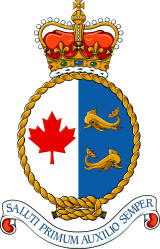 |
Description: The Canadian Coast Guard delivers civilian marine services (vessels, aircraft, expertise, personnel and infrastructure) on behalf of other federal government departments or in support of federal agencies and organizations in the achievement of their own specific Government of Canada maritime priorities. CCG provides support to other parts of Fisheries and Oceans Canada (Science and Conservation and Protection), the Department of National Defence, Environment Canada, the Royal Canadian Mounted Police, the Department of Foreign Affairs, and Transport Canada among others. |  |
| Resources and Results | 2009-2010 | 2010-2011 | 2011-2012 |
|---|---|---|---|
| $ Millions | $701.1 | $792.7 | $961.9 |
| FTEs | 4,778 | 4,778 | 4,778 |
| Expected Result | Safe, economical and efficient movement of maritime traffic in Canadian waters | ||
| Percentage of traffic accidents vs. vessel clearances | |||
| Expected Result | Minimize loss of life or injury resulting from marine incidents | ||
| Confidence in the Canadian Coast Guard's ability to deliver SAR Services | |||
| Expected Result | Minimize impacts of ship source oil spills in Canadian waters | ||
| Confidence in the Canadian Coast Guard's ability to deliver ER Services | |||
| Expected Result | Civilian fleet operationally ready to deliver Government of Canada programs and maintain a federal presence | ||
| The extent to which CCG is meeting Government of Canada requirement for an operationally ready fleet | |||
| CCG has committed to consulting with clients and stakeholders and adjusting its Performance Measurement Framework, where required. As a proxy, CCG will assess its performance against the extent to which all sub activity targets are met | |||
Note: These figures include Treasury Board adjustments and funding announced in the 2009 Federal Budget.
Key Priority: Canadian Coast Guard Rejuvenation
Canadian Coast Guard Rejuvenation aims to make meaningful progress in areas related to client service, the effective and efficient delivery of CCG programs and services, and CCG's workforce.
| Key plans and commitments related to CCG Rejuvenation are further detailed in the CCG Business Plan, published annually, each June. | 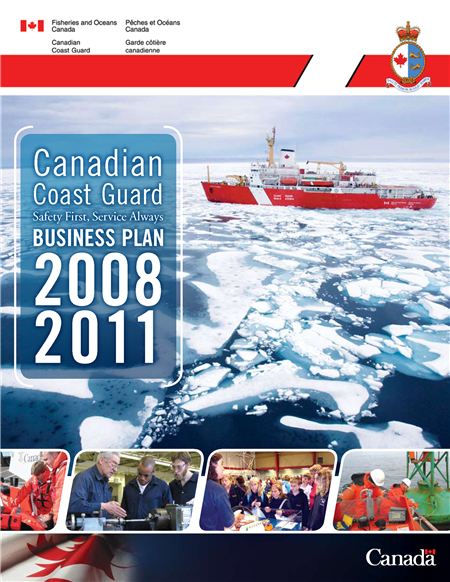 |
Key Initiative: Focus on Client Service
CCG is working to improve client service by reviewing its levels of service with client groups. In 2007-2008, an examination of CCG's Levels of Service and Service Standards began, with over 30 client consultation sessions. In 2009-2010, CCG will revise the Levels of Service and Service Standards document, taking into account the analysis of comments received from clients in previous years. CCG will also continue to refine Service Level Agreements with internal clients.
CCG provides platforms and assets to support government priorities and other government departments in the areas of maritime security, Canada's Northern Strategy, and the environment.
| 2009-2010 | 2010-2011 |
|---|---|
|
|
|
|
|
|
|
|
|
|
|
Key Initiative: Focus on Effectiveness and Efficiency
To ensure the effective and efficient delivery of its programs, CCG is renewing its fleet and shore-based assets via improved lifecycle asset management and a 25-year Fleet Renewal Strategy. Unfortunately, the construction of 12 mid-shore patrol vessels, approved in federal budgets since 2005, has been delayed because the bids received exceeded the funds allocated. In 2009-2010, CCG will work with Public Works and Government Services Canada to re-issue the Request for Proposal, with the goal of awarding a contract to the successful bidder.
Budgets 2006 and 2007 also provided resources for the purchase of three off-shore fisheries science vessels and one off-shore oceanographic science vessel, and Budget 2008 provided for a new Polar Class icebreaker to replace CCGS Louis S. St-Laurent. Work toward the delivery of the science vessels and the icebreaker will continue in 2009-2010 through 2011-2012.
Budget 2009 provides additional funding of $175 million for the purchase of 98 small craft (including 30 replacement environmental response barges); a number of new vessels, including three inshore science vessels (to replace existing vessels); as well as funds to repair and overhaul 40 large vessels. These investments will enhance fleet renewal and vessel maintenance initiatives and will strengthen our overall capacity, particularly in Search and Rescue and in environmental response across the country.
To strengthen the linkages among its strategic vision, long-term capital plans, and in year budget allocations, CCG will put in place an Integrated Infrastructure Investment Plan.
CCG is also taking steps to innovate or update technologies. For example, Aids to Navigation of the 21st Century (AToN21) considers the changing navigational needs of users, ensuring that the right mix of aids to navigation is available, and lays the foundation for an efficient and effective service. The Agency is also moving toward one system for the management of vessel traffic.
CCG's efforts to strengthen management will further enhance effectiveness and efficiency. Coast Guard will continue to work toward national consistency in planning, reporting, and management practices. A key commitment in this area includes the development of a Strategic Program Framework that will result in the systematic examination of the six Maritime Services programs to ensure that they focus on key priority areas. Work will also continue on the implementation of recommendations of CCG's 2007-2008 Vessel Maintenance Management Review, which was conducted in response to findings of the February 2007 Report of the Auditor General.
| 2009-2010 | 2010-2011 | 2011-2012 |
|---|---|---|
| Renewing the Fleet and Shore-based Assets | ||
|
|
|
|
|
|
|
|
|
|
||
|
||
| Modernization through Innovation and Technology | ||
|
||
|
||
|
||
| Strengthening Management | ||
|
||
|
Implement the CCG Vessel Maintenance Management Framework | |
|
Implement the CCG Vessel Condition Continuous Survey Program | |
Key Initiative: Focus on People
Like many other organizations, Coast Guard faces an increasingly competitive labour market. For example, CCG needs to retain highly skilled mariners, as well as other technical and operational specialists, and it needs to recruit new staff because of upcoming retirements.
In 2008-2009, the Agency continued to strengthen its capacity for succession planning by integrating human resource and corporate business planning, with an emphasis on improving diversity. Through 2009-2010 and beyond, CCG will focus on attracting and retaining a skilled workforce, improving the diversity of its workforce, providing training and development for staff, and ensuring national consistency in human resource management.
| 2009-2010 | 2010-2011 | 2011-2012 |
|---|---|---|
|
|
|
|
||
|
| Small Craft Harbours | Program Activity |
|---|
Description: The Small Craft Harbours Program directly, or indirectly through Harbour Authorities, operates and maintains a network of harbours, critical to the fishing industry, open, safe and in good repair. These harbours are necessary for the effective operation of the commercial fisheries that contribute to the Canadian economy, directly support employment, and indirectly create tens of thousands of jobs, many in rural and isolated parts of Canada.
| Resources and Results | 2009-2010 | 2010-2011 | 2011-2012 |
|---|---|---|---|
| $ Millions | $192.8 | $246.7 | $116.8 |
| FTEs | 133 | 147 | 147 |
| Expected Result | A network of harbours critical for Canada's commercial fishing industry that is open, safe, and in good repair | ||
| Percentage of core fishing harbours with performance ratings of fair, good or very good | |||
| 70% | 70% | 70% | |
| Percentage of facilities at core fishing harbours in fair, good or very good condition | |||
| 80% | 80% | 80% | |
| Percentage of core fishing harbours that have Environmental Management Plans in place | |||
| 95% | 95% | 95% | |
| Expected Result | HAs are able to effectively manage and maintain core commercial fishing harbours | ||
| Percentage of existing core fishing harbours managed by HAs | |||
| 90% | 90% | 90% | |
| Expected Result | Recreational and non-essential fishing harbours are divested | ||
| Percentage of recreational and non-core harbours divested | |||
| 5% divested | 5% divested | 5% divested | |
Note: These figures include Treasury Board adjustments and funding announced in the 2009 Federal Budget.
Budget 2009 provided Small Craft Harbours with additional funding in 2009-2010 and 2010-2011 to invest in harbour repair, maintenance, and dredging at core fishing harbours ($200 million) and to accelerate the construction of a fishing harbour in Pangnirtung, Nunavut ($17 million).
Key Priority: Supporting the Northern Strategy
Fishing harbours continue to be the most critical public infrastructure of the fisheries and seafood sector. While Nunavut's commercial fishery is currently in its developmental stage, DFO and the Government of Nunavut have jointly assessed the Territory's infrastructure needs. The assessment advised that seven community harbours were warranted to facilitate the Territory's commercial fisheries and to support other regional interests.
| Link to Northern Strategy priority here (in priorities table) |
Key Initiative: Pangnirtung Harbour, Nunavut
Budget 2008 announced funding for a community harbour in Pangnirtung, Nunavut. This initiative is supported by the Science Sector's initiative to provide hydrographic support for the harbour ("Key Initiative: Hydrographic Data and Products in Support of Pangnirtung Harbour,") and by aids to navigation provided by the Canadian Coast Guard.
| 2009-2010 | 2010-2011 | 2011-2012 |
|---|---|---|
|
|
|
Key Priority: Small Craft Harbours
The SCH Program provides harbour infrastructure to the commercial fishing industry. A safe and functional harbour infrastructure, combined with strong and viable local management of harbours, will over time increase the capacity to generate harbour revenues locally. This will in turn create socioeconomic benefits for the commercial fishing industry and local communities.
To achieve this, the Program continues to address harbour rust-out and the changing needs of the industry. While funding pressures have been managed so far, the current structure of the Program is not sustainable in the long run. DFO will therefore investigate ways to help ensure the sustainability of the SCH Program by developing and implementing proposals for Program sustainability and continuing to divest non core fishing and recreational harbours.
Harbour Authorities are facing increasing demands for services, while experiencing low support and low turnover of volunteers. Without Harbour Authorities, SCH would be unable to maintain and operate its network of harbours. The Program must therefore develop ways to support this important group of volunteers.
Key Initiative: Sustainable Harbours
Small Craft Harbours is developing proposals for making the Program more sustainable, along with ways to reduce rust-out and address lifecycle management and investment needs. The proposals will include both what can be accomplished within existing resource levels and what can be achieved with additional funding.
| 2009-2010 | 2010-2011 | 2011-2012 |
|---|---|---|
|
|
Key Initiative: Sustainable Harbour Authorities
The Program is developing tools and training packages to support the sustainability and viability of Harbour Authorities. This includes developing a compendium of competencies, a Harbour Authority Maintenance Manual, tools to provide guidance for setting and collecting fees, and tools for use by Harbour Authority Boards of Directors.
| 2009-2010 | 2010-2011 | 2011-2012 |
|---|---|---|
|
|
|
| Science for Safe and Accessible Waterways | Program Activity |
|---|
| Description: This program provides scientific research, monitoring, advice, products and services and data management to ensure departmental and federal policies, programs, decisions, and regulations associated with safe, secure, and accessible waterways are informed by science advice. The science is provided through a network of research facilities, in collaboration with other government departments, private sector, academia and international organizations. | 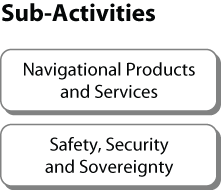 |
| Resources and Results | 2009-2010 | 2010-2011 | 2011-2012 |
|---|---|---|---|
| $ Millions | $35.3 | $38.2 | $32.0 |
| FTEs | 281 | 281 | 281 |
| Expected Result | Stakeholders have the information to safely navigate Canada's waterways | ||
| Number of navigational digital and paper products sold | |||
| Increase digital navigational charts to converge with paper chart production year over year | |||
Key Priority: Supporting the Department's International Agenda
Key Initiative: United Nations Convention on the Law of the Sea
The ratification of the United Nations Convention on the Law of the Sea (UNCLOS) in 2003 requires Canada to submit evidence within ten years to the United Nations Commission on the Limits of the Continental Shelf in support of its territorial claim to the continental shelf beyond the current 200-mile Exclusive Economic Zone.
The Canadian Hydrographic Service (CHS) is responsible for completing bathymetric survey work in support of Canada's submission of evidence to the United Nations Commission on the Limits to the Continental Shelf (UNCLCS).
This work is concentrated in three areas: the Western Arctic (Beaufort Sea and Canada Basin), Eastern Arctic (Alpha and Lomonosov Ridges), and the Atlantic Ocean from the Labrador Sea to the United States border. The greatest challenges to bathymetric data collection have been experienced in the Arctic. Finalizing DFO's contribution to the submission requires three more years of survey work.
| 2009-2010 | 2010-2011 | 2011-2012 |
|---|---|---|
|
||
|
||
|
||
|
||
Key Priority: Supporting the Northern Strategy
Key Initiative: Hydrographic Data and Products in Support of Pangnirtung Harbour
CHS will provide hydrographic support for the design of the harbour facility in Pangnirtung, Nunavut, as well as updates to nautical products once the harbour is established. Initial data needs include information on tides, currents, and near-shore bathymetry.
As the new harbour nears completion, CHS will verify depth information in dredged areas and near new structures. Once the facility is operational, CHS will maintain all relevant navigational publications, including charts, sailing directions, and tide tables.
| Bathymetry is the study of the underwater depths of lakes or ocean floors. A bathymetric map or chart usually shows floor relief or terrain and may provide information on surface navigation. |
| 2009-2010 | 2010-2011 | 2011-2012 |
|---|---|---|
|
||
|
||
|
||
Sustainable Fisheries and Aquaculture
| Resources | 2009-2010 | 2010-2011 | 2011-2012 |
|---|---|---|---|
| $ Millions | $471.3 | $465.8 | $464.5 |
| FTEs | 2,559 | 2,608 | 2,615 |
| Description | Delivering an integrated fisheries and aquaculture program that is credible, science based, affordable, and effective, and contributes to sustainable wealth for Canadians | ||
| Measure | Year over year improvement in management and conservation of major stocks to support sustainable fisheries, as evidenced in growth of the sustainability index (baseline 5.4 out of 10)3 | ||
| Target | 4% | 3% | 2% |
3 This baseline is preliminary, as it is based on an incomplete data set for 2008. Resource Management will have a final number for 2008 by the end of March 2009. We expect a declining increase over time as more management tools and measures to support sustainability are put in place and improvements in fisheries outcomes are realized. It will be harder to close the final gap - to make those final, most challenging improvements.
Sustainable Fisheries and Aquaculture provides Canadians with economic benefits from our aquatic natural resources. Ensuring that these products have access to world markets and working with other nations to protect and conserve the resources is critical. The Department seeks to maximize the socioeconomic benefits to Canadians arising from recreational fisheries and First Nations fisheries. Understanding and managing the complex ecosystems to allow these benefits to accrue in a sustainable fashion is the work of:
- Fisheries and Aquaculture Management
- Science for Sustainable Fisheries and Aquaculture
Sustainable Fisheries and Aquaculture contributes to these Government of Canada outcome areas:
|
Canada's commercial fishery is characterized by a multitude of small operators and a handful of large, vertically integrated companies that continually face challenges that are a complex mix of biological, economic, and social factors. The viability of many coastal communities is directly linked to the health of the fisheries. New technologies have made it easier to catch and process far more fish than can be harvested sustainably. The recreational fishery, with direct annual expenditures of $7.5 billion, is an important contributor to the Canadian economy.
Precautionary and ecosystem approaches support resource sustainability and economic prosperity for commercial, Aboriginal, and recreational fish harvesters, with the common goal of a sustainable, economically viable, internationally competitive industry. DFO continues to work with others to develop recovery strategies, make adjustments to fisheries facing serious challenges, and develop a conservation ethic that values long-term objectives for the resource over short-to-medium-term social or economic goals.
Canada's aquaculture industry is characterized by a substantial yet largely unrealized growth potential. The industry consists of many small and medium-sized companies, as well as a few large ones. Both the medium-sized and large companies are often partially vertically integrated. Aquaculture supports the viability of a growing number of coastal and Aboriginal communities, providing mostly year-round and relatively well-paid jobs.
DFO's vision for aquaculture is to create the conditions necessary for the development of a sustainable and environmentally responsible aquaculture sector in Canada. This requires a streamlined regulatory environment, harmonized standards and practices, and enhanced public confidence in the sector.
Sound science provides the basis for informed decision-making and an innovative and knowledge-based economy. Departmental priorities associated with Fisheries Renewal, the international agenda, and sustainable aquaculture require scientific support to ensure that the associated policies, programs, and regulations have a sound basis in the natural sciences.
| Fisheries and Aquaculture Management | Program Activity |
|---|
| Description: The overall goal of fisheries and aquaculture management is the conservation of Canada's fisheries resources to ensure sustainable resource utilization through close collaboration with resource users and stakeholders based on shared stewardship. Fisheries and Aquaculture Management is responsible for international fisheries conservation negotiations and relations, shared management of interception fisheries in international waters, management of the Aboriginal, commercial, recreational fishing in the coastal waters of Canada's three oceans and creating the conditions for a vibrant and innovative aquaculture industry. | 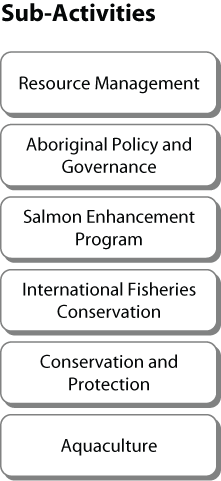 |
| Resources and Results | 2009-2010 | 2010-2011 | 2011-2012 |
|---|---|---|---|
| $ Millions | $331.6 | $330.1 | $324.2 |
| FTEs | 1,554 | 1,600 | 1,607 |
| Expected Result | Sustainable fisheries and aquaculture | ||
| Year over year improvement in management and conservation of stocks to support sustainable fisheries, as evidenced in growth of the sustainability index | |||
| 4% | 3% | 2% | |
Note: These figures include Treasury Board adjustments and funding announced in the 2009 Federal Budget.
Key Priority: Fisheries Renewal
Fisheries Renewal is focusing on revising programs and policies that are preventing sectors from generating maximum benefits from limited resources. Positive changes have been made in pursuit of a Fisheries Renewal agenda that supports a modern, self-reliant, stable, and adaptable harvesting sector. Nevertheless, more work is required to consolidate, entrench, and build on these advances.
Fisheries Renewal is a three-year initiative to put in place policies, tools, and mechanisms to support a robust and diverse fisheries sector - a sector that includes a broad range of resource users (Aboriginal, recreational, or commercial) and has a role for organizations and individuals interested in the outcomes of fisheries decision-making.
Fisheries Renewal is founded on a strong policy renewal platform and builds on DFO's context and commitments. It has developed out of recent policy initiatives across the country, from a variety of regional fisheries management approaches, from international commitments, and from stricter market requirements.
A key objective of Fisheries Renewal is to develop an enabling, transparent governance system to allow resource users and others involved with the resource to affect or to make decisions in support of their economic prosperity while ensuring the sustainability of the resource.
Fisheries Renewal also aims to deliver an integrated fisheries program that is credible, science-based, affordable, and effective and that contributes to economic prosperity for Canadians. This will be achieved by helping DFO and resource users meet conservation objectives; enabling resource users to effectively respond to the economic forces that affect their industry; increasing stability, transparency, and predictability in fisheries management; and modernizing the legislative framework that governs fisheries management.
The sensitive benthic areas policy, the forage species policy, the fishery checklist (a self-diagnostic tool), and the new integrated fisheries management plan template are examples of this ongoing work.
| Benthic species are organisms that live on the seabed and the bottom of rivers and lakes, including organisms that live in and on sediments or inhabit rocky substrata. Forage species are small aquatic species that larger predators prey on. |
Key Initiative: Atlantic Integrated Commercial Fisheries Initiative
The Atlantic Integrated Commercial Fisheries Initiative (AICFI) has been developed to achieve sustainable, integrated fisheries in which all participants fish under common and transparent rules. AICFI will help participating First Nations communities develop their commercial fishing enterprises and co-management capacity so they can manage their fishing enterprises and maximize the potential value of access to the fishery. These rights were obtained through the Marshall Response Initiative, which was completed on March 31, 2007.
| 2009-2010 | 2010-2011 | 2011-2012 |
|---|---|---|
|
|
|
|
|
|
Key Initiative: Pacific Integrated Commercial Fisheries Initiative
The Pacific Integrated Commercial Fisheries Initiative (PICFI) responds to the conservation and sustainability challenges facing Pacific fisheries and the need for greater co-operation among fish harvesters. The initiative is central to fisheries reforms that will secure the long-term sustainability and economic viability of Pacific fisheries while supporting First Nations' aspirations for greater participation in integrated commercial fisheries and fisheries management.
Through this initiative, DFO is seeking to advance common and transparent rules for all commercial fisheries; to strengthen accountability through improved catch monitoring, data reporting, and compliance; and to improve traceability measures. In addition, demonstration fisheries are being undertaken to explore new approaches to managing fisheries, including share-based management of salmon fisheries.
| 2009-2010 | 2010-2011 | 2011-2012 |
|---|---|---|
|
|
|
|
|
Key Priority: Sustainable Aquaculture
Aquaculture in Canada now accounts for about 33% of the total value of Canadian fish and seafood production. The sector continues to demonstrate tremendous potential for growth, as global demand for fish and seafood continues to exceed the production capacity of wild fisheries. The Canadian aquaculture industry has, however, expanded much more slowly than its international competitors.
DFO's goal is to stimulate substantial growth in the industry in a sustainable manner by reducing or removing constraints on development and creating the conditions necessary for a successful aquaculture industry.
For the industry to become internationally competitive and environmentally and socially sustainable, strong federal leadership is required in governance and regulatory reform, scientific research in support of sustainable production, innovation, and certification and market access.
Key Initiative: The Aquaculture Program Initiative
This initiative seeks to create the conditions necessary for the success of the Canadian aquaculture sector by reducing some of the key constraints it currently faces. This will be accomplished through regulatory and policy reform, as well as direct contributions to spur innovation and investments by the industry.
A renewed governance for the implementation of the aquaculture program consists of the Departmental Aquaculture Management Committee and the Departmental Aquaculture Operations Committee. Coordination across provinces and territories with the federal government is enhanced by the Interdepartmental Committee on Aquaculture and the Canadian Council of Fisheries and Aquaculture Ministers Task Group. Co-ordination with industry is achieved through the Aquaculture Industry Liaison Committee. Achieving the governance objectives also requires support from the Science sector in providing research and advice.
| 2009-2010 | 2010-2011 | 2011-2012 |
|---|---|---|
|
||
Key Priority: Market Access
The seafood sector is facing serious economic challenges in the form of new requirements for access to current and potential markets. Strong market access supports a self-reliant industry and economic prosperity. To maintain or increase market access, the export seafood industry and government departments that regulate and enable industry activities must now demonstrate, with supporting evidence, that fish and seafood products are safe and are derived from sustainably managed and legal fisheries.
| Traceability, in relation to the seafood industry, is the ability to trace fishery products through the harvesting, processing, and retail stages to demonstrate that the products originate in fisheries that are sustainably managed and legal. |
Canada does not currently have in place a fully integrated traceability system for meeting these requirements. This has generated considerable concern from provincial counterparts and industry stakeholders. If this situation persists over the longer term, Canada will lose market share.
DFO will make changes to the management of our fisheries to support market access through legislation, regulation, policy, negotiations, and increased advocacy efforts with others along the seafood value chain. DFO will work to create the necessary conditions to maintain and improve market access, thus optimizing economic benefits and increasing stability in our fisheries sector.
| The seafood value chain consists of fish harvesters, buyers/brokers, processors, marketing boards, distributors, and exporters. |
DFO is developing a Market Access Action Plan to explore the Department's evolving role in addressing current and emerging seafood market access pressures. The Department, along with other federal government departments, provinces, and territories, is working on supporting industry to meet the current and emerging domestic and international requirements — eco-certification and concerns with food safety — by developing and implementing an integrated traceability strategy and system.
| Science for Sustainable Fisheries and Aquaculture | Program Activity |
|---|
| Description: Provision of advice and recommendations based on scientific research and monitoring, as well as the provision of products and services and the management of data on Canada's oceans and resources. This ensures departmental and federal policies, programs, decisions, and regulations associated with sustainable fisheries and aquaculture are informed by scientific knowledge. The science is provided through a network of research facilities, in collaboration with other government departments, private sector, academia and international organizations. | 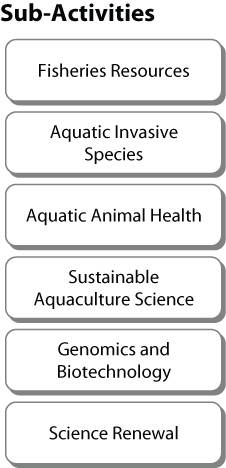 |
| Resources and Results | 2009-2010 | 2010-2011 | 2011-2012 |
|---|---|---|---|
| $ Millions | $139.7 | $135.7 | $140.3 |
| FTEs | 1,006 | 1,009 | 1,009 |
| Expected Result | Comprehensive understanding of living aquatic resources | ||
| Number of requests for science advice on living aquatic resources | |||
| Complete 90% of requests for science advice on living aquatic resources that senior management approves | |||
| Number of Canadian Science Advisory Secretariat (CSAS) publications on living aquatic resources that are posted on the DFO web site | |||
| Maintain 5-year average | |||
| Number of publicly available products on living aquatic resources completed by DFO Science | |||
| Maintain 5-year average | |||
Note: These figures include Treasury Board adjustments and funding announced in the 2009 Federal Budget.
Key Priority: Science Renewal
The Government of Canada continues to make significant investments in science and technology. The policy direction provided in Canada's new Science and Technology Strategy: Mobilizing Science and Technology to Canada's Advantage underscores the importance of scientific information and advice in support of public policy development and decision-making. Recent investments in science in support of sustainable aquaculture, fisheries science research, and seabed mapping in support of Canada's submission to the United Nations Commission on the Limits of the Continental Shelf are vital to the delivery of DFO's priorities.
Given this supporting role, the Department's Science Program must ensure that its efforts are aligned with the needs of decision-makers today while being strategically prepared to meet the requirements of tomorrow.
Key Initiative: International DFO Science Strategy
The collaborative nature of scientific endeavours puts science in a unique position to both support and influence international relationships and to leverage science resources. To maximize the contribution of the Science Program in the international arena, the Department will develop an International Science Strategy with the specific objectives of:
- Leveraging finite science resources and building capacity through strategic alliances with international leaders in priority science areas
- Supporting the attainment of DFO's policy and management objectives regarding international fisheries and oceans
- Supporting Canada's international science and technology objectives
- Supporting Canada's foreign policy and trade objectives
| 2009-2010 | 2010-2011 | 2011-2012 |
|---|---|---|
|
||
Key Initiative: Implementation of the Multi-year Strategic and Operational Planning Framework
To ensure a comprehensive approach to the renewal of the Science Program, we have completed an overarching multi-year strategic and operational planning framework that provides direction on the way forward and links the various enabling strategies, plans, and initiatives under the Science Renewal priority.
While the Framework is complete, the strategies, plans, and initiatives associated with the Framework are in various stages of implementation. By 2010-2011, the Science Program will have fully implemented the renewal of the Science Program, including an evaluation of results achieved against a performance measurement framework.
| 2009-2010 | 2010-2011 | 2011-2012 |
|---|---|---|
|
||
Key Priority: Supporting Fisheries Renewal
Key Initiative: Ecosystem-based Approach
The Science Program will support Fisheries Renewal by broadening its ecosystem-based approach to science. This approach will provide increased knowledge of fisheries resources, their productivity, and the ecosystem factors affecting them. This includes research to integrate ecosystem elements in assessments and forecasts, the design and evaluation of harvest strategies, the enhanced collection and analysis of oceanographic data in support of interpretations of variations in the abundance of fish populations, and support for marine mammal surveys on a rotational basis.
| 2009-2010 | 2010-2011 | 2011-2012 |
|---|---|---|
|
||
Key Priority: Supporting Sustainable Aquaculture
Key Initiative: Aquaculture Regulatory Science
The objective of aquaculture regulatory science is to increase the science knowledge base needed to support informed ecosystem-based environmental regulation and decision-making, especially that of regulatory-based programs such as Habitat Management and Aquaculture Management. Research areas and associated projects will be prioritized on the basis of the needs of aquaculture regulatory management. Peer-reviewed state-of-knowledge reports and workshops will also play a key role in informing aquaculture regulatory management, policy development, and decision-making.
| 2009-2010 | 2010-2011 | 2011-2012 |
|---|---|---|
|
||
Key Priority: Supporting the Department's International Agenda
Key Initiative: Increased Understanding of Marine Ecosystems
In support of the Department's International Agenda priority, the Science Program will continue to undertake research to improve our understanding of marine ecosystems and our knowledge of straddling stocks and highly migratory species such as tuna, swordfish, and Greenland halibut.
The Science Program will also support, through its research, initiatives designed to protect high seas marine habitat and communities. These initiatives include identifying and characterizing vulnerable marine ecosystems, as well as improving the sustainability of fishing practices and harvesting strategies.
| 2009-2010 | 2010-2011 | 2011-2012 |
|---|---|---|
|
||
Healthy and Productive Aquatic Ecosystems
| Resources | 2009-2010 | 2010-2011 | 2011-2012 |
|---|---|---|---|
| $ Millions | $146.4 | $142.0 | $137.3 |
| FTEs | 1,163 | 1,181 | 1,181 |
| Expected Result | Sustainable development and integrated management of resources in or around Canada's aquatic environment through oceans and fish habitat management | ||
| Measure | Number of policies developed and implemented that serve the public interest via the sustainable development of Canada's oceans and freshwater resources | ||
| Target | 18 Habitat policies 5 SAR policies |
21 Habitat policies 5 SAR policies |
24 Habitat policies 5 SAR policies |
| Measure | Number of programs in place that serve the public interest via the sustainable development of Canada's oceans and freshwater resources | ||
| Target | 8 Habitat programs 3 Oceans programs 1 SAR program |
8 Habitat programs 2 Oceans programs 1 SAR program |
8 Habitat programs 10 Oceans programs 1 SAR program |
| Measure | Number of formal partnership arrangements established that serve the public interest via the management of human activities in and around aquatic ecosystems | ||
| Target | 18 national-level partnerships on the management of fish habitat 1 Oceans management partnership 4 SAR management partnerships |
18 national-level partnerships on the management of fish habitat 1 Oceans management partnership 6 SAR management partnerships |
18 national-level partnerships on the management of fish habitat 1 Oceans management partnership 8 SAR management partnerships |
Oceans and freshwater biodiversity, resources, and habitat are an important part of Canada's environmental, social, cultural, and economic fabric. However, the diverse needs of multiple users put great pressure on marine and freshwater resources and environments. Economic growth associated with inland, onshore, and off-shore development has had and will continue to have a significant impact on Canada's marine and freshwater systems.
The benefits associated with this strategic outcome are provided by:
- Oceans Management
- Habitat Management
- Species at Risk Management
- Science for Healthy and Productive Aquatic Ecosystems
Healthy and Productive Aquatic Ecosystems contributes to these Government of Canada outcome areas:
|
The aquaculture industry and natural fisheries both depend on productive fish-bearing waters, and both can have negative impacts on the broader ecosystem.
Key challenges in managing Canada's oceans and freshwater include oceans health, loss of marine habitat, declining biodiversity, growing demands for access to ocean resources, and regulatory and jurisdictional complexities. Public decision-making about activities in and around Canadian waterways strikes a balance between equally important but competing interests: the economic and social benefits associated with development on one hand, the long-term health and sustainability of Canada's ecosystems on the other.
The conservation and protection of unique and endangered habitats, endangered or threatened marine species, and marine areas of high biodiversity is becoming increasingly complex. In large-scale projects such as Alberta's oil sands and natural resource developments in Canada's North and British Columbia, the potential for environmental degradation is commensurate with the potential for growth and development.
Conserving and protecting aquatic species at risk — marine mammals, fish, and marine plants - remains an important challenge for DFO. The need to share responsibilities across federal, provincial, and territorial governments and wildlife management boards is also a complicating factor.
Having a sound scientific understanding of species, habitats, and ecosystems is fundamental to the Department's response to these challenges.
| Oceans Management | Program Activity |
|---|
| Description: Oceans management involves the conservation and sustainable use of Canada's oceans in collaboration with other levels of government, Aboriginal organizations and other non-government stakeholders through the development and implementation of objectives-based integrated oceans management plans and the application of marine conservation tools. Modern oceans management arrangements deal with a number of challenges including oceans health, marine habitat loss, declining biodiversity, growing demands for access to ocean resources and regulatory and jurisdictional complexities. | 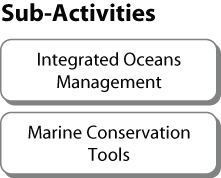 |
| Resources | 2009-2010 | 2010-2011 | 2011-2012 |
|---|---|---|---|
| $ Millions | $16.4 | $15.7 | $15.1 |
| FTEs | 117 | 118 | 118 |
| Expected Result | Canada's ocean areas managed through adoption of integrated management approaches | ||
| Estimated percentage of Canadian ocean area with integrated management structures | |||
| 31% | 31% | 31% | |
| Expected Result | Coordinated and effective oceans governance | ||
| Percentage of Large Ocean Management Areas with inter-jurisdictional Regional Implementation Committees or equivalents | |||
| 100% | 100% | 100% | |
| Percentage of Large Ocean Management Areas with Stakeholder Advisory Committees or equivalent | |||
| 100% | 100% | 100% | |
Key Priority: Health of the Oceans
The intent of the Health of the Oceans priority is to strengthen our ability to prevent, detect, and reduce pollution; increase protection for ecologically significant marine areas; enhance co-operation with provincial/territorial, Aboriginal, domestic, and international partners; and increase scientific investments in understanding the oceans. The Government of Canada will also be increasing its research and protection activities in Canada's Arctic waters.
Through its part in the Health of the Oceans initiative, Fisheries and Oceans Canada will support the establishment of a national system of Marine Protected Areas (MPAs), the designation of six new MPAs under the Oceans Act, additional science advice related to marine protection, the creation of four new virtual centres of expertise, and enhanced oil-spill response capacity in the Arctic Ocean.
Key Initiatives
DFO will support a number of initiatives related to Oceans Management, including the creation of new Oceans Centres of Expertise, the implementation of the Federal Marine Protected Area Strategy, the establishment of MPAs, and the implementation of the CCG Arctic Response Strategy.
DFO will coordinate accountability for all Health of the Oceans initiatives. This will include bi-annual performance monitoring, the development of summary annual reports, and the preparation of a final formative evaluation. DFO will track how these projects protect sensitive ocean areas, control pollution, and promote collaborative oceans management.
| 2009-2010 | 2010-2011 | 2011-2012 |
|---|---|---|
|
|
|
|
||
|
||
|
||
| Habitat Management | Program Activity |
|---|
| Description: In collaboration with others, Habitat Management involves conserving and protecting fish and fish habitat from the impacts of activities occurring in and around fresh and marine fish-bearing waters, and improving (restoring and developing) fish habitat through the administration of the habitat protection provisions of the Fisheries Act, providing advice on related provisions of the Act, and the application of non-regulatory activities. It also involves conducting environmental assessments prior to regulatory decisions listed in the Law List Regulations of the Canadian Environmental Assessment Act and participating in other environmental assessment regimes. These activities are performed in a manner consistent with the Species at Risk Act; the Policy for the Management of Fish Habitat and other operational policies; consultation with Aboriginal groups; the goals and principles of sustainable development; and the policies and priorities of the federal government. | 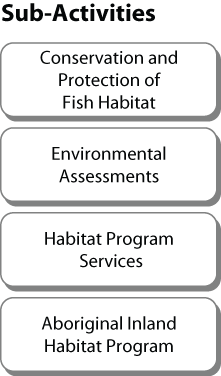 |
| Resources and Results | 2009-2010 | 2010-2011 | 2011-2012 |
|---|---|---|---|
| $ Millions | $57.7 | $54.7 | $54.5 |
| FTEs | 563 | 575 | 575 |
| Expected Result | Healthy and productive fish habitat available to sustain the production of fish species and populations that Canadians value | ||
| Percentage of Fisheries Act authorizations with compensation plans to offset the loss of fish habitat as a result of development projects | |||
| 100% | 100% | 100% | |
| Percentage of inspected works and undertakings that conform with terms and conditions of operational statements, formal advice in writing, and Fisheries Act authorizations | |||
| 100% | 100% | 100% | |
Key Initiative: Regulatory Improvement Initiative for Major Resource Projects
Budget 2007 committed to reducing the length of the federal regulatory review process for major resource projects to an average of two years. To support this commitment, DFO was allocated resources for regulatory activities under the Fisheries Act, as well as for responsibilities associated with environmental assessments and Aboriginal consultations related to major resource projects. Budget 2007 also announced the creation of a Major Projects Management Office (MPMO) within Natural Resources Canada that will oversee this initiative.
| 2009-2010 | 2010-2011 | 2011-2012 |
|---|---|---|
|
|
|
|
|
|
| Species at Risk Management | Program Activity |
|---|
| Description: Aquatic species at risk are managed to provide for the recovery of extirpated, endangered and threatened species; and the management of special concerned species to prevent them becoming at risk. This program activity involves developing recovery strategies, action plans and management plans for all aquatic species; promoting recovery implementation and monitoring of marine and anadromous (moving between fresh and salt water) species over which the federal government has exclusive jurisdiction; and promoting freshwater species for which certain provinces have specific delegated responsibilities related to fisheries management through regulations under the Fisheries Act. | 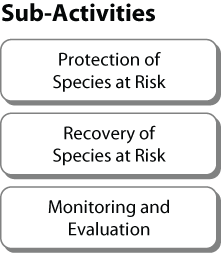 |
| Resources and Results | 2009-2010 | 2010-2011 | 2011-2012 |
|---|---|---|---|
| $ Millions | $16.9 | $17.1 | $17.7 |
| FTEs | 34 | 38 | 38 |
| Expected Result | Conservation and protection of aquatic species at risk in Canada | ||
| Percentage of recovery strategies, recovery action plans, and management plans developed within the legislated timelines, and in conformity with mandated requirements while addressing the backlog | |||
| 60% | 80% | 100% | |
Key Priorities: Supporting the Health of the Oceans
Key Initiatives
The protection, management, and recovery of species at risk are key elements of DFO's strategy to protect and preserve our aquatic resources, ecosystems, and habitats. In many cases, these species are a prominent part of Canada's natural heritage. DFO works closely with Environment Canada and the Parks Canada Agency to ensure a common framework and approach to the implementation of the Species at Risk Act (SARA). A proactive approach is taken with regard to species of special concern to prevent them from becoming at risk.
Aside from the upcoming parliamentary review of SARA, the most visible component of this horizontal activity will be the finalization of the species at risk policy suite, which will provide the policy framework for all federal activities related to the implementation of SARA.
| 2009-2010 | 2010-2011 | 2011-2012 |
|---|---|---|
|
|
|
|
|
|
|
||
| Science for Healthy and Productive Aquatic Ecosystems | Program Activity |
|---|
| Description: This program provides research, monitoring, advice, products and services and data management to ensure departmental and federal policies, programs, decisions, and regulations associated with the integrated management of Canada's oceans and fish habitat resources are informed by science advice. The science is undertaken through a network of research facilities, in collaboration with other government departments, private sector, academia and international organizations. | 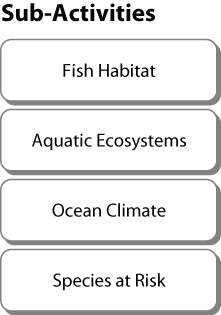 |
| Resources and Results | 2009-2010 | 2010-2011 | 2011-2012 |
|---|---|---|---|
| $ Millions | $55.4 | $54.4 | $50.0 |
| FTEs | 450 | 451 | 451 |
| Expected Result | Comprehensive understanding of aquatic ecosystem function | ||
| Number of requests for science advice on aquatic ecosystems | |||
| Complete 90% of requests for science advice on aquatic ecosystems that senior management approves | |||
| Number of Canadian Science Advisory Secretariat (CSAS) publications on aquatic ecosystems that are posted on the DFO website | |||
| Maintain 5-year average | |||
| Number of publicly available products on aquatic ecosystems completed by DFO Science | |||
| Maintain 5-year average | |||
Key Priority: Supporting the Health of the Oceans
Key Initiative: Identifying Indicators for MPAs
The Science Program will support the identification of science-based indicators for the conservation objectives of MPAs. Once indicators have been identified, monitoring protocols will be developed. These protocols will provide guidance on incorporating ecosystem indicators into monitoring programs and will facilitate appropriate quality assurance when these indicators are used.
| 2009-2010 | 2010-2011 | 2011-2012 |
|---|---|---|
|
|
|
|
||
Key Initiative: Sector Impact Advisories
The Science Program will provide scientific assessment and advice about the potential environmental impacts and ecological risks associated with specific high-priority ocean activities identified by the Oceans, Habitat and Species at Risk Program. Science will also conduct review and advisory meetings for priority oceans activities.
| 2009-2010 | 2010-2011 | 2011-2012 |
|---|---|---|
|
||
Supporting All the Department's Outcomes: Internal Services
| Internal Services4 are groups of related activities and resources that are administered to support the needs of programs and other corporate obligations of an organization. These groups are: Management and Oversight Services; Communications Services; Legal Services; Human Resources Management Services; Financial Management Services; Information Management Services; Information Technology Services; Real Property Services; Materiel Services; Acquisition Services; and Travel and Other Administrative Services. | 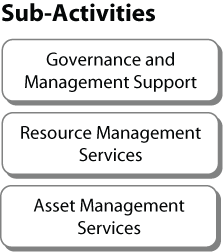 |
| Resources | 2009-2010 | 2010-2011 | 2011-2012 |
|---|---|---|---|
| $ Millions | $311.9 | $297.9 | $297.6 |
| FTEs | 1,898 | 1,942 | 1,942 |
Within Internal Services, Governance and Management Support provides the Department with the strong governance needed to allow its programs and services to provide the greatest benefits possible to Canadians with DFO's resources and assets. Communications, Legal Services, and the Executive Secretariat, in Governance and Management Support, play important roles in the Department's activities. Policy, Evaluation, and Audit all play an important role in development of programs and priorities, and in ensuing that programs are efficient and effective.
Asset Management Services works to ensure that the infrastructure that supports the Department's activities can perform as expected and is maintained and replaced in a strategic fashion.
Resource Management Services involves providing sound financial management, modern and flexible human resource management, and a comprehensive approach to information technology and management that protects vital information and makes it readily accessible for decision-making.
Treasury Board Secretariat uses a tool called the Management Accountability Framework (MAF) to provide departments with recommendations for improving their internal management. This framework, along with the analysis of key corporate risks, allows senior management to determine the Department's management priorities.
Over the coming year, organizations within the Internal Services program activity will work to address several key departmental management priorities.
4 In August 2007, Treasury Board Secretariat (TBS) promulgated The Revised Profile of the Government of Canada's Internal Services to be used by departments in their reporting documents. The services formerly called Program Enablers were renamed the Internal Services Program Activity and organized in a new structure determined by TBS. The discussion in this document follows that structure.
Key departmental management priorities:
|
